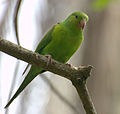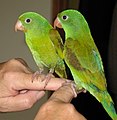Brotogeris
| Brotogeris | |
|---|---|

| |
| Plain parakeet | |
| Scientific classification | |
| Domain: | Eukaryota |
| Kingdom: | Animalia |
| Phylum: | Chordata |
| Class: | Aves |
| Order: | Psittaciformes |
| Family: | Psittacidae |
| Subfamily: | Arinae |
| Genus: | Brotogeris Vigors, 1825 |
| Type species | |
| Psittacus pyrrhopterus (grey-cheeked parakeet) Latham, 1801
| |
| Species | |
|
see text | |
Brotogeris is a genus of small parrots endemic to Central and South America. Their closest relatives are the monk parakeet and the cliff parakeet in the genus Myiopsitta. They eat seeds and fruit.[1] The word brotogeris means "having the voice of a human". In the language of their native countries, which is mostly Spanish, they are called pericos – the translation of which is "parakeet". Their average lifespan is 15 years, although some have been reported to have lived up to 35 years. Also, the bird was found in Rio Grande do Sul in South America.[citation needed]
Taxonomy
[edit]The genus Brotogeris was introduced in 1825 by Irish zoologist Nicholas Aylward Vigors with the grey-cheeked parakeet as the type species.[2][3] The name is from the Ancient Greek brotogērus meaning "with human voice".[4]
The genus contains eight species:[5]
| Image | Common Name | Scientific name | Distribution |
|---|---|---|---|
 |
Tui parakeet | Brotogeris sanctithomae | Brazil, and Amazonian Peru, Bolivia, eastern Ecuador, and south-eastern Colombia. |
 |
Plain parakeet | Brotogeris tirica | Brazil. |
 |
White-winged parakeet | Brotogeris versicolurus | southeast Colombia to the river's mouth in Brazil. |
 |
Yellow-chevroned parakeet, canary-winged parakeet | Brotogeris chiriri | central Brazil to southern Bolivia, Paraguay, and northern Argentina. |
 |
Grey-cheeked parakeet | Brotogeris pyrrhoptera | northwestern Peru and western Ecuador |
 |
Orange-chinned parakeet, Tovi parakeet | Brotogeris jugularis [1] | from Mexico, through Central America, to Venezuela. |
 |
Cobalt-winged parakeet | Brotogeris cyanoptera | Venezuela, Colombia, Ecuador, Peru, and Bolivia; and Brazil |
 |
Golden-winged parakeet | Brotogeris chrysoptera | Brazil, French Guiana, Guyana, Suriname, (the Guianas), and Venezuela |
Phylogeny
[edit]The species form a monophyletic group whose closest relatives are the monk parakeet and the cliff parakeet in the genus Myiopsitta. Within Brotogeris the species are divided into two separate clades.[6]
| |||||||||||||||||||||||||||||||||||||||||||||||||
Gallery
[edit]-
Plain parakeet
(B. tirica) -
Grey-cheeked parakeet
(B. pyrrhoptera) -
Yellow-chevroned parakeet
(B. chiriri) -
Orange-chinned parakeet
(B. jugularis) -
Cobalt-winged parakeet
(B. cyanoptera) -
Tui parakeet
(B. sanctithomae)
References
[edit]- ^ a b Alderton, David (2003). The Ultimate Encyclopedia of Caged and Aviary Birds. London, England: Hermes House. p. 196. ISBN 1-84309-164-X.
- ^ Vigors, Nicholas Aylward (1825). "On the arrangement of the genera of birds". Zoological Journal. 2: 391–405 [400].
- ^ Peters, James Lee, ed. (1937). Check-List of Birds of the World. Vol. 3. Cambridge, Massachusetts: Harvard University Press. p. 205.
- ^ Jobling, James A. (2010). The Helm Dictionary of Scientific Bird Names. London: Christopher Helm. p. 78. ISBN 978-1-4081-2501-4.
- ^ Gill, Frank; Donsker, David; Rasmussen, Pamela, eds. (January 2022). "Parrots, cockatoos". IOC World Bird List Version 12.1. International Ornithologists' Union. Retrieved 22 March 2022.
- ^ Ribas, C.C.; Miyaki, C.Y.; Cracraft, J. (2009). "Phylogenetic relationships, diversification and biogeography in Neotropical Brotogeris parakeets". Journal of Biogeography. 36 (9): 1712–1729. Bibcode:2009JBiog..36.1712R. doi:10.1111/j.1365-2699.2009.02131.x. S2CID 84453966.
Further reading
[edit]Bencke, Glayson A., 2010.New and significant bird records from Rio Grande do Sul, with comments on biogeography and conservation of the southern Brazilian avifauna. IHERINGIA SERIE ZOOLOGIA, 100(4), 391–402. 10.1590/S0073-47212010000400014




